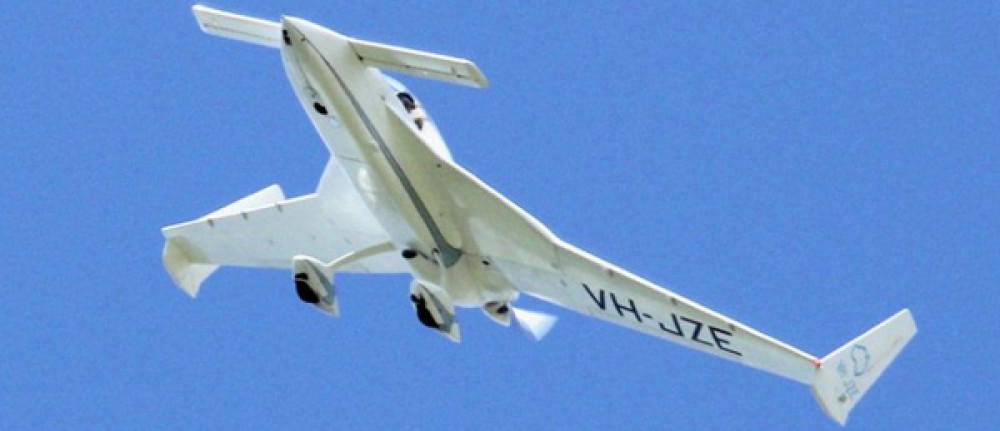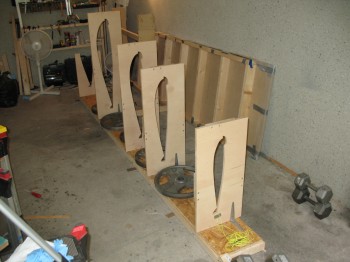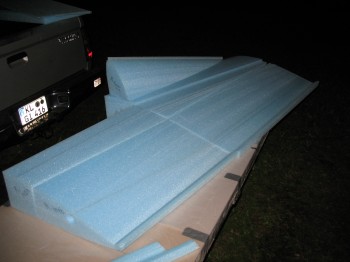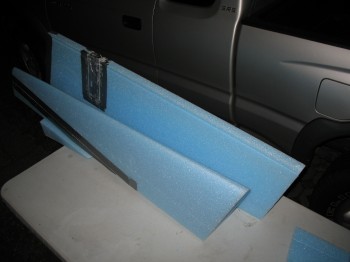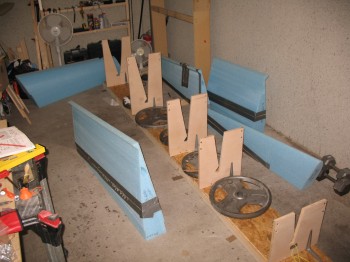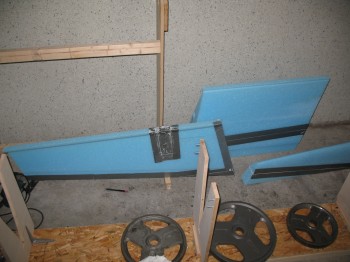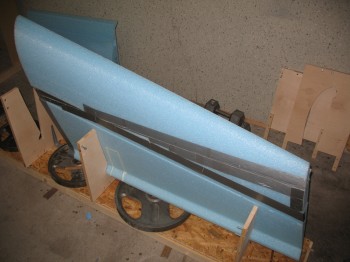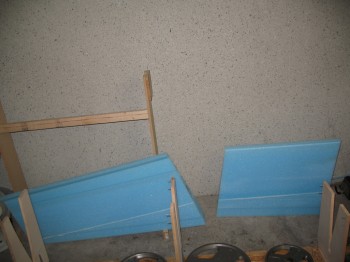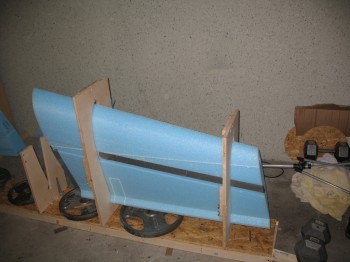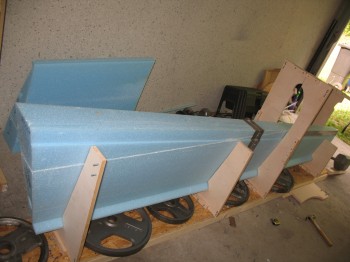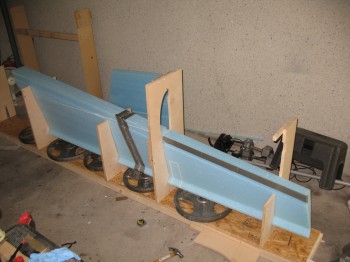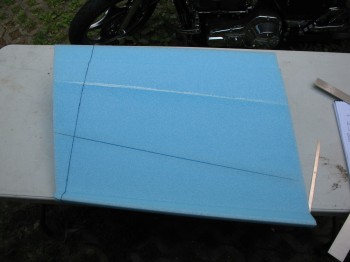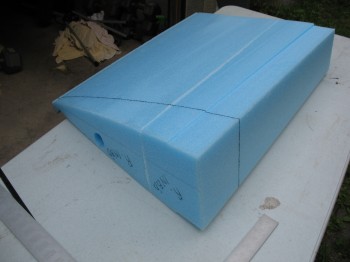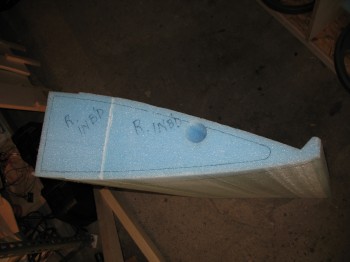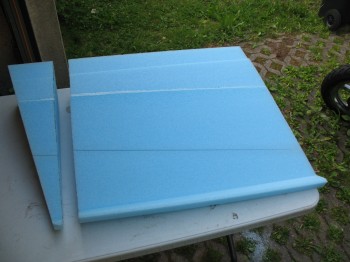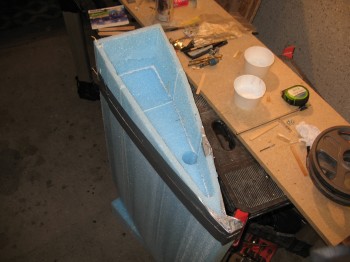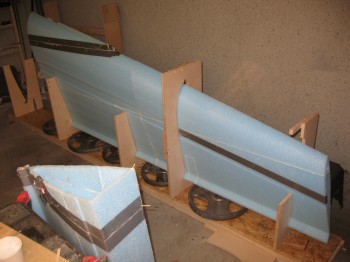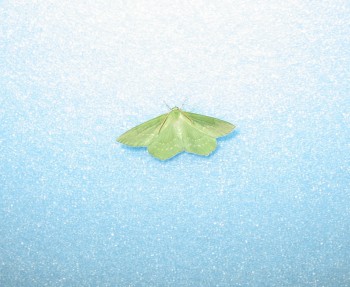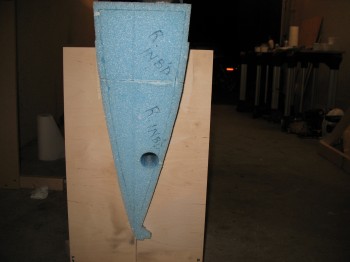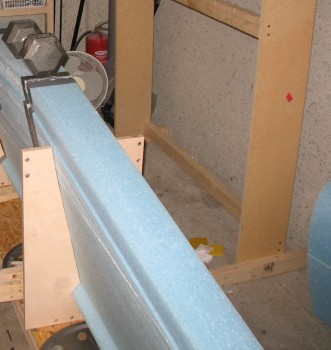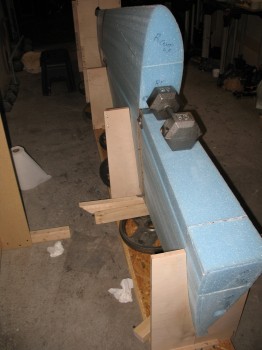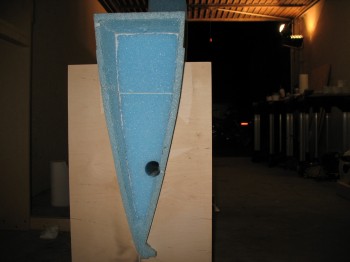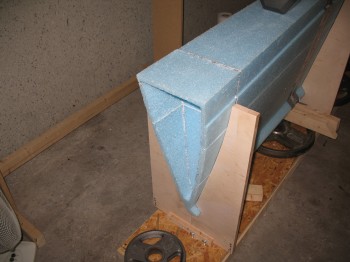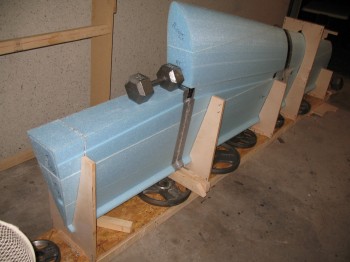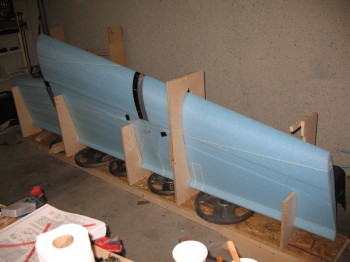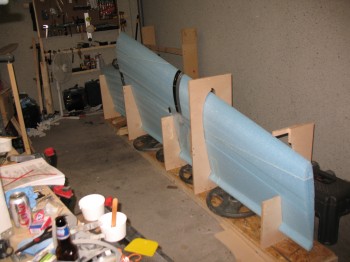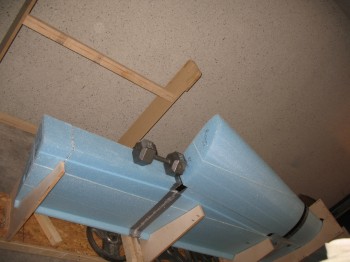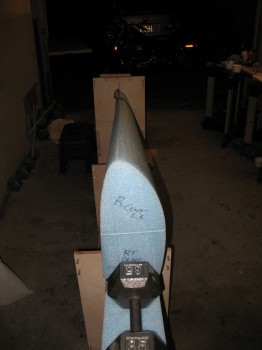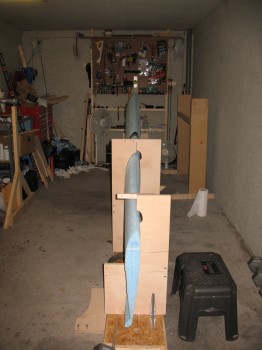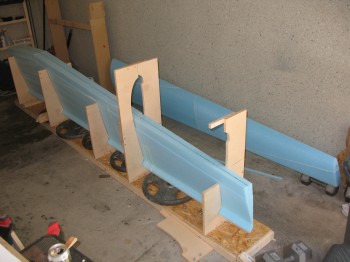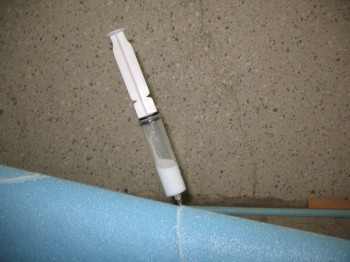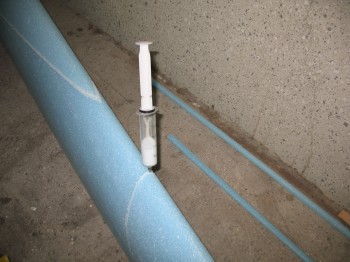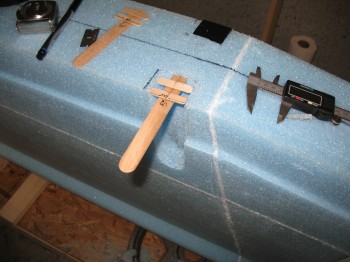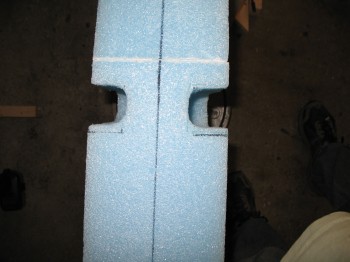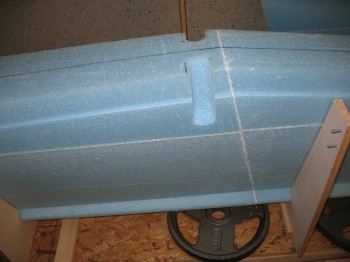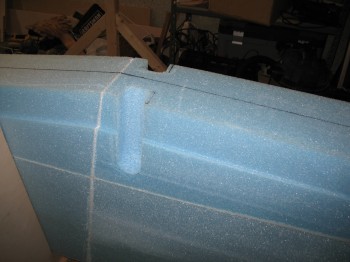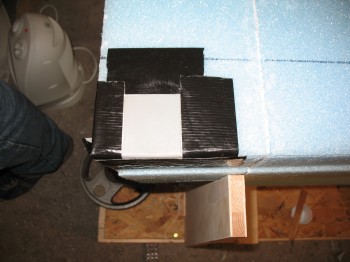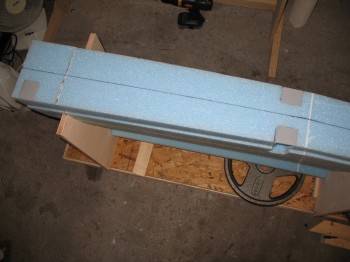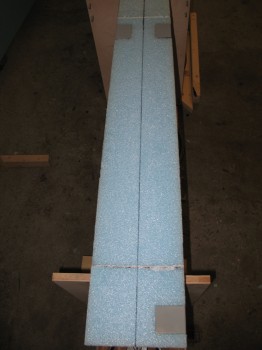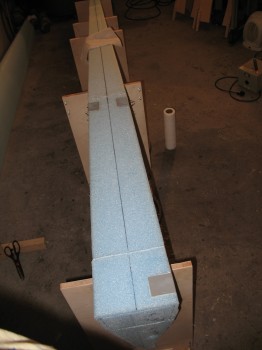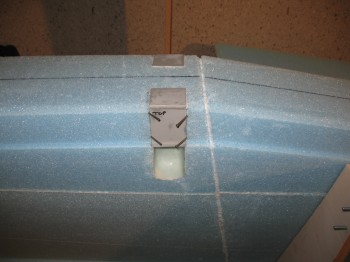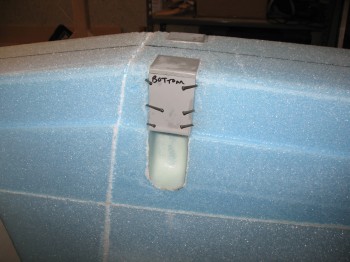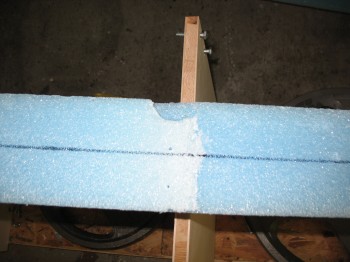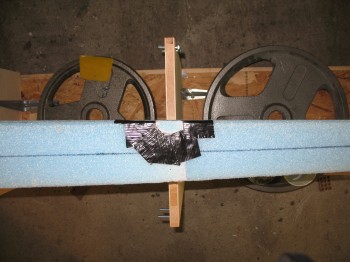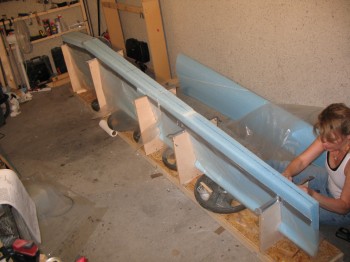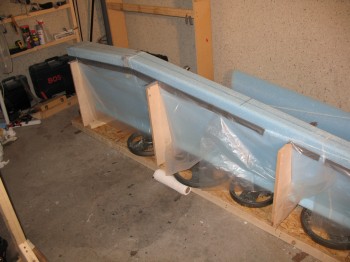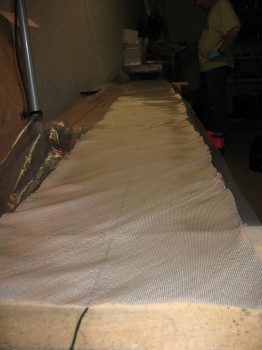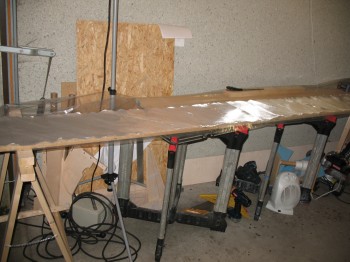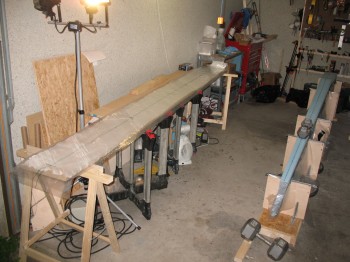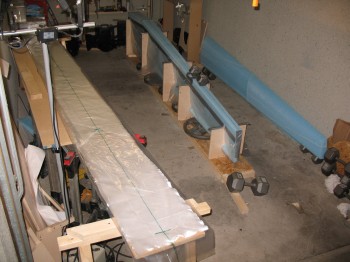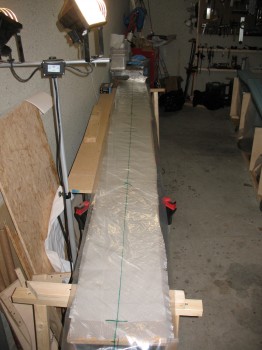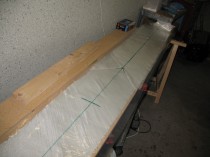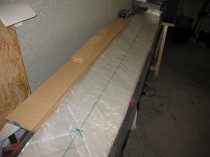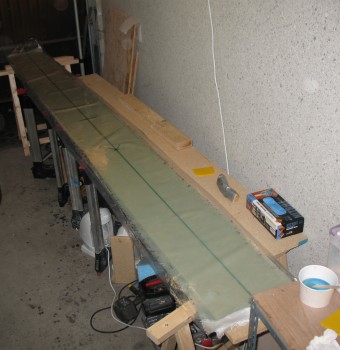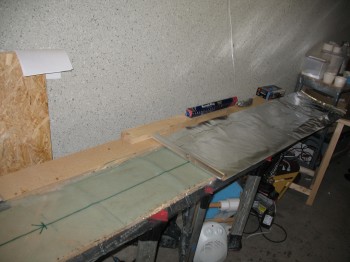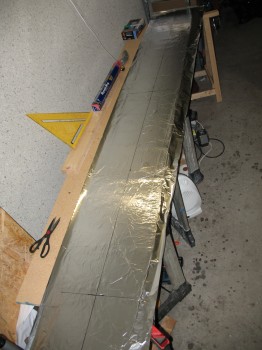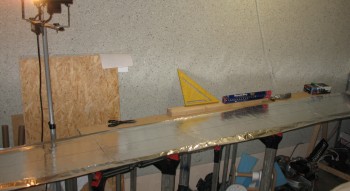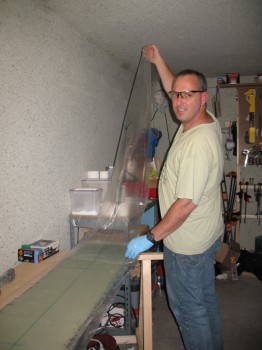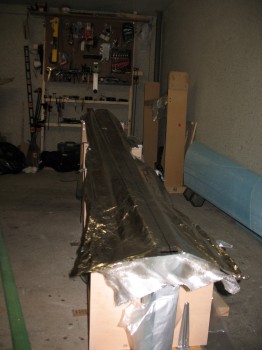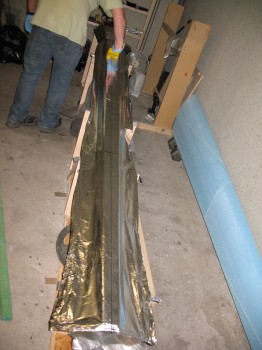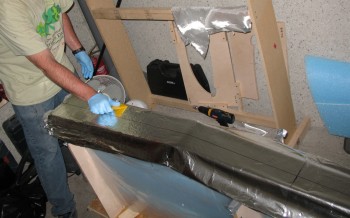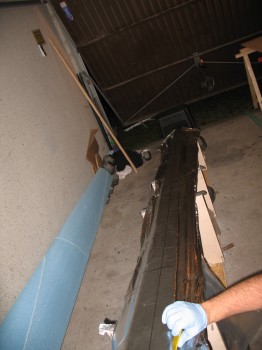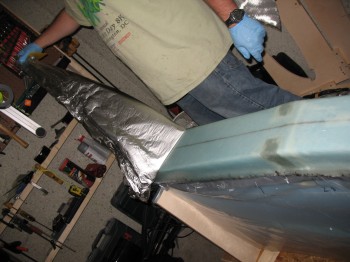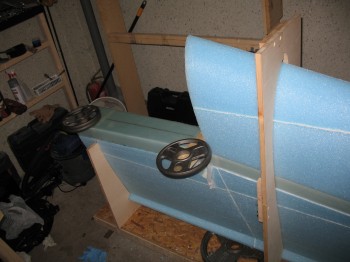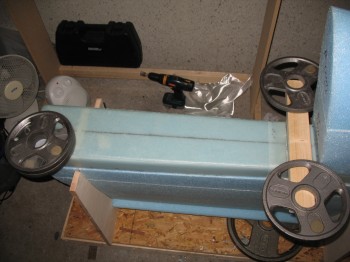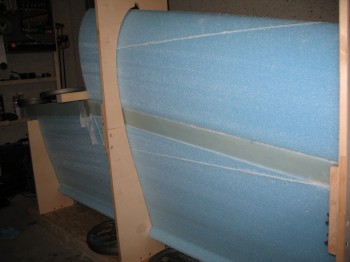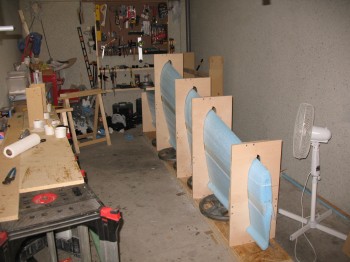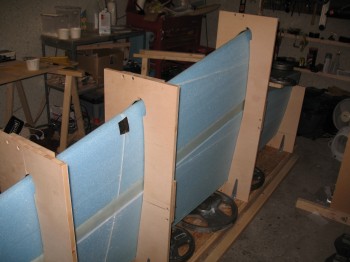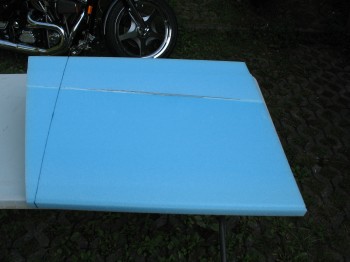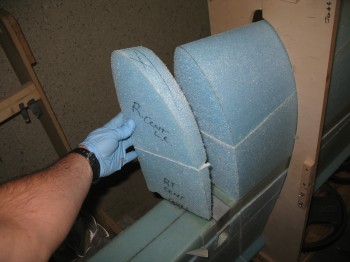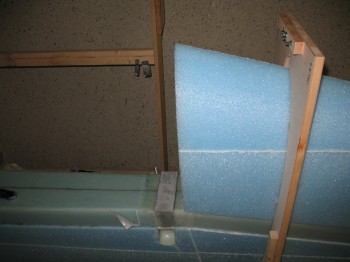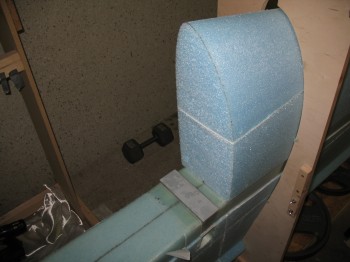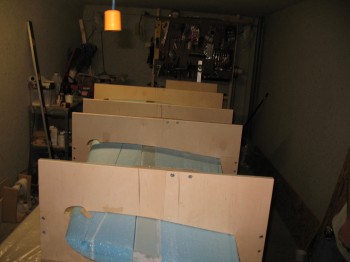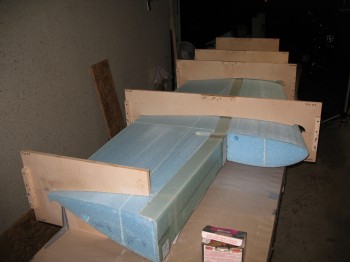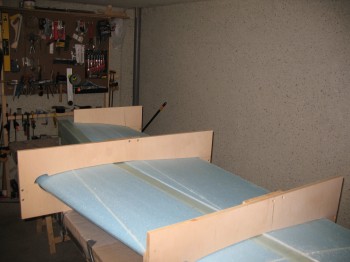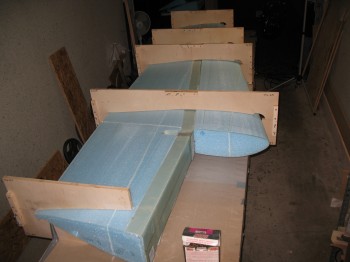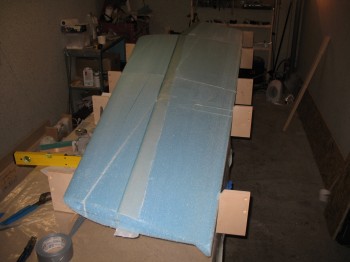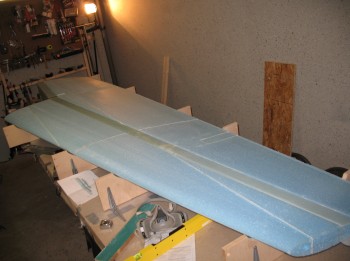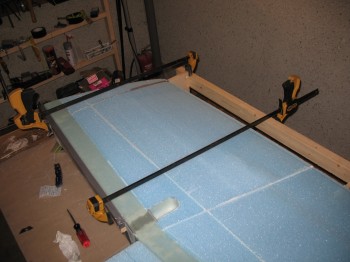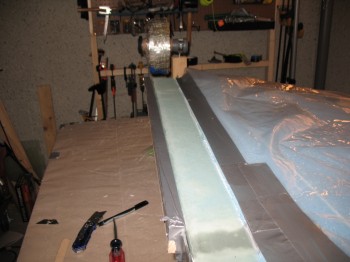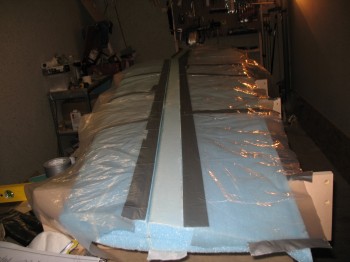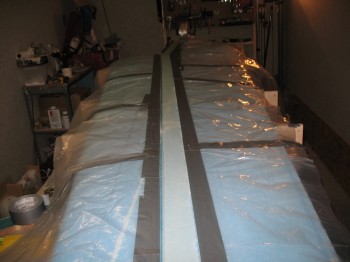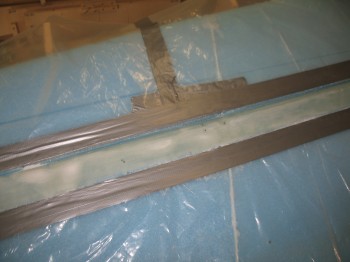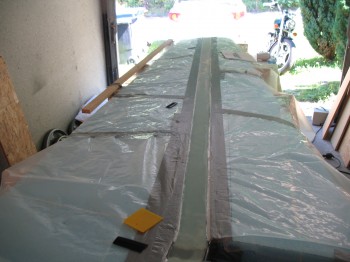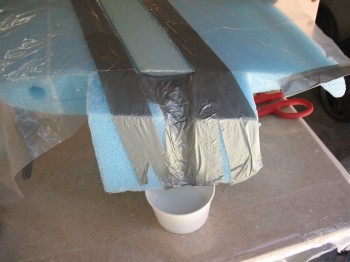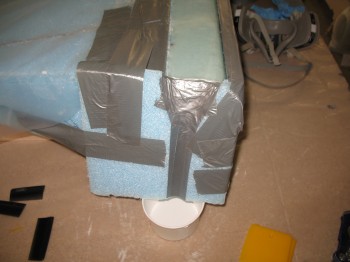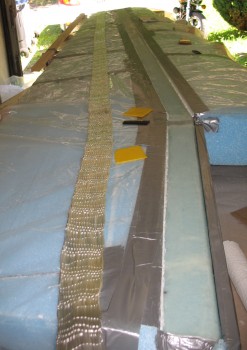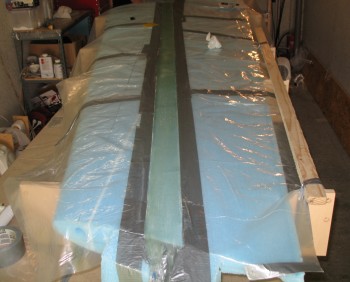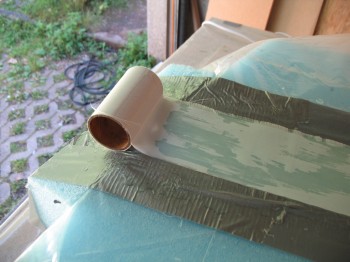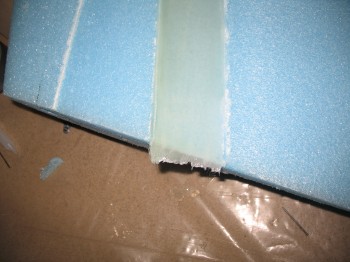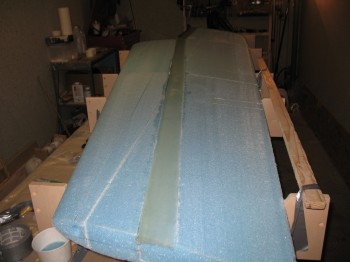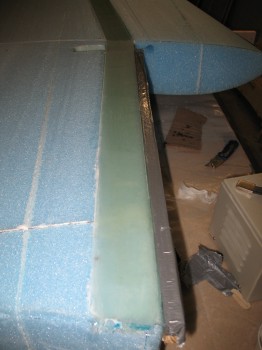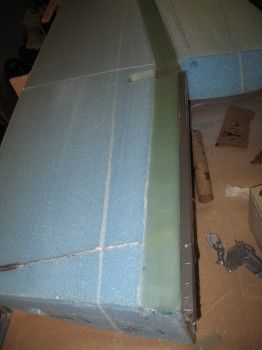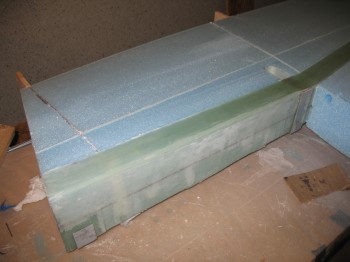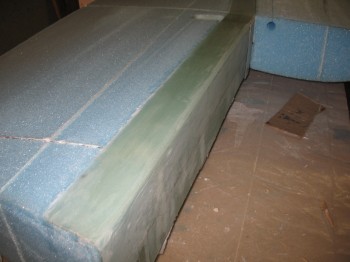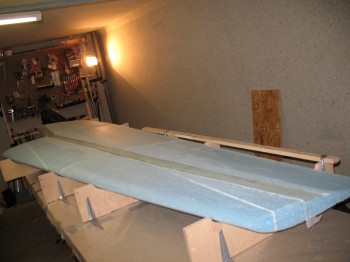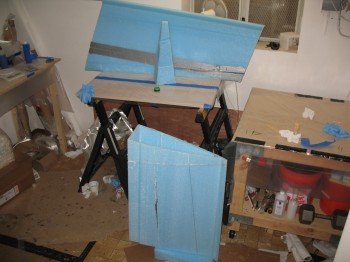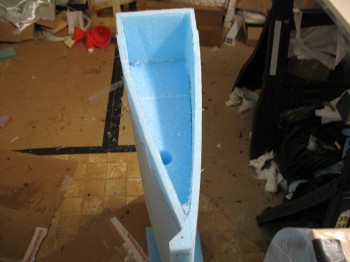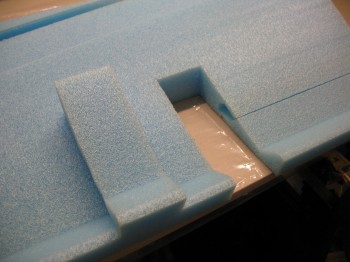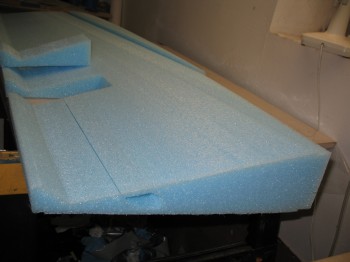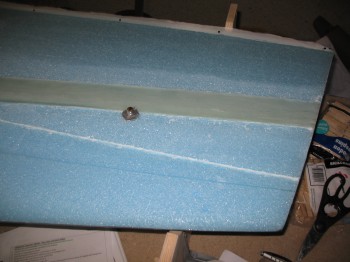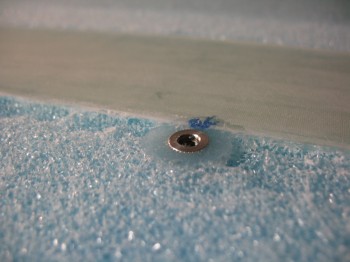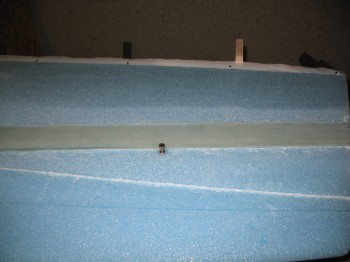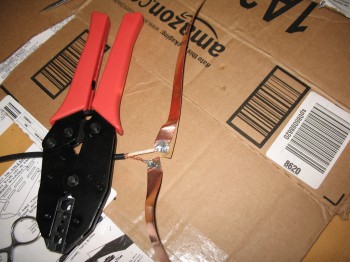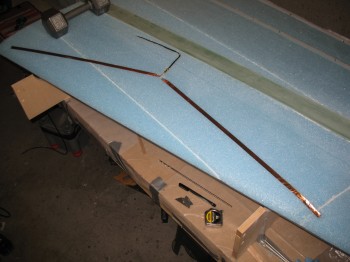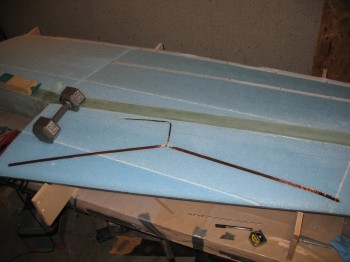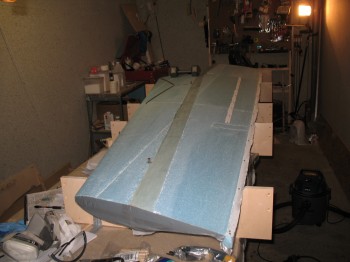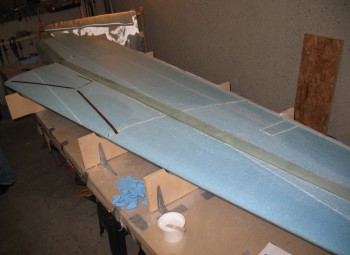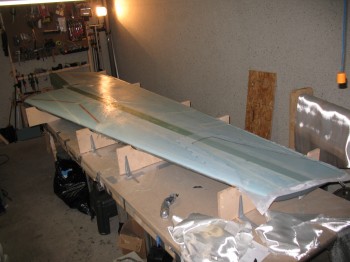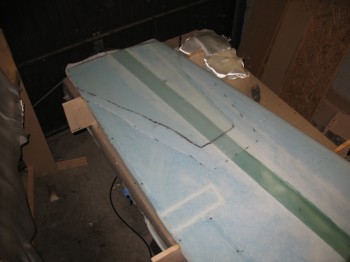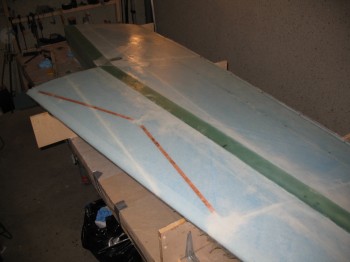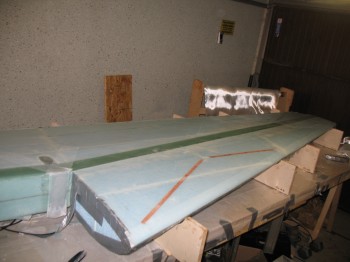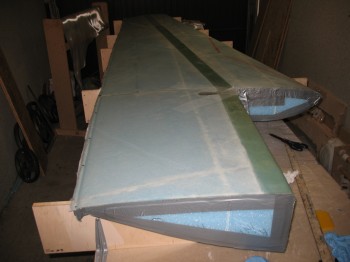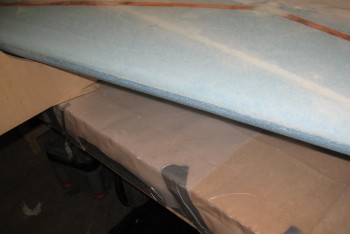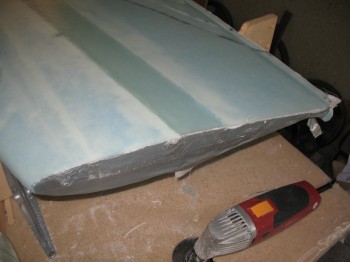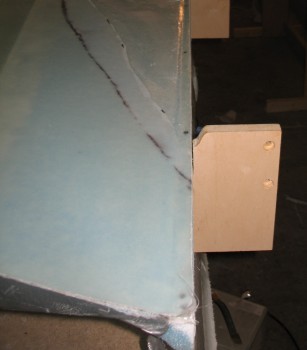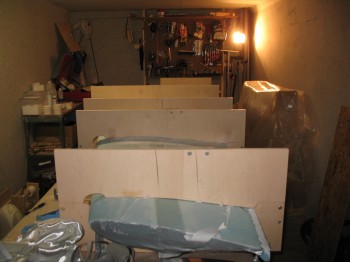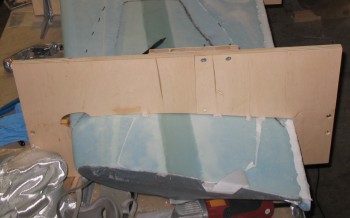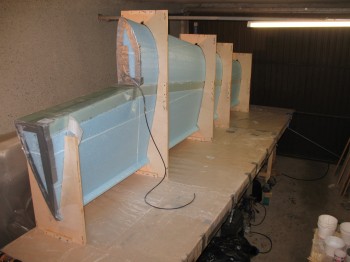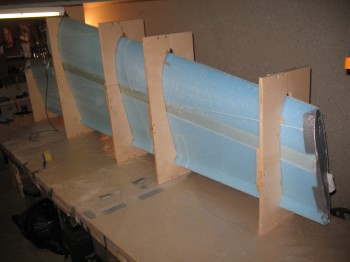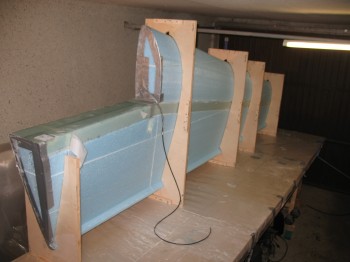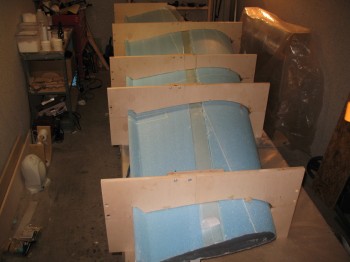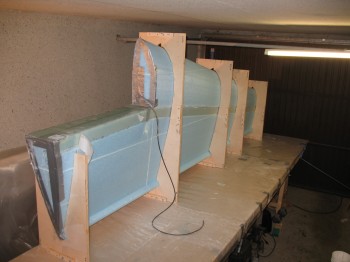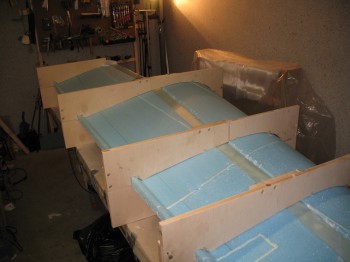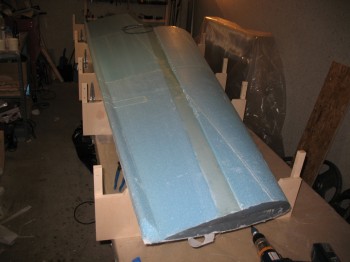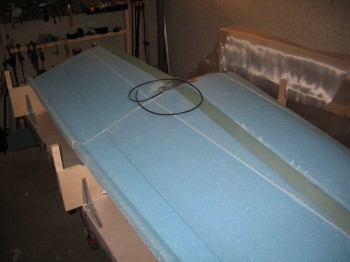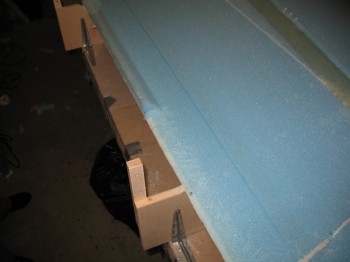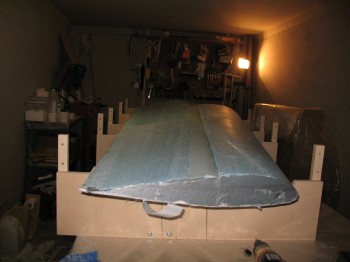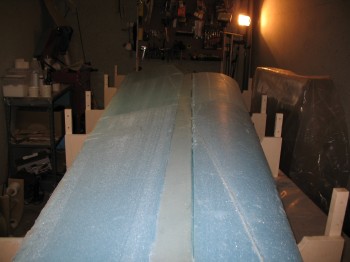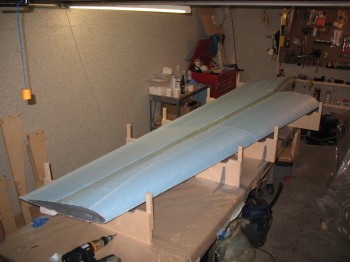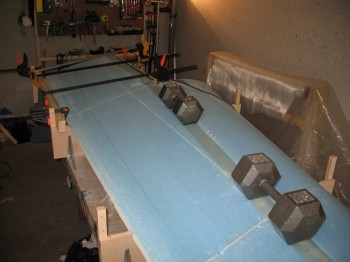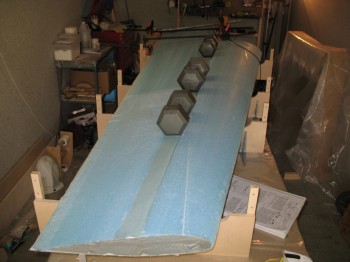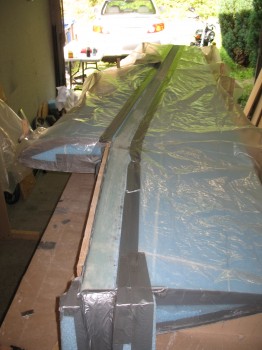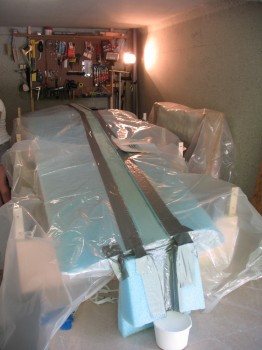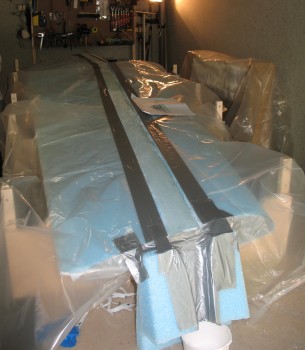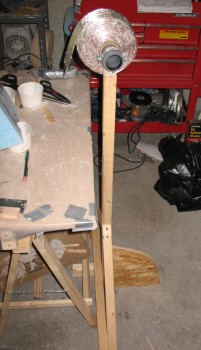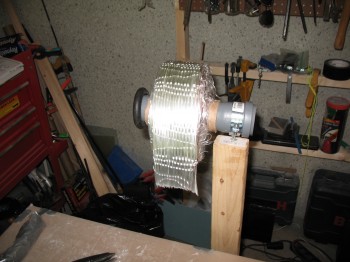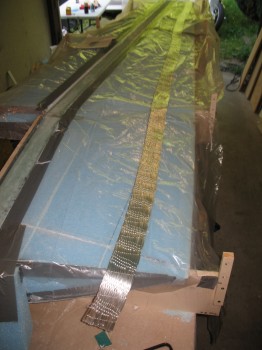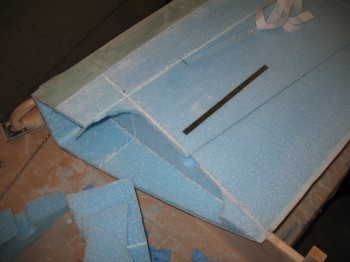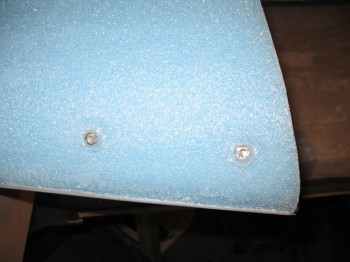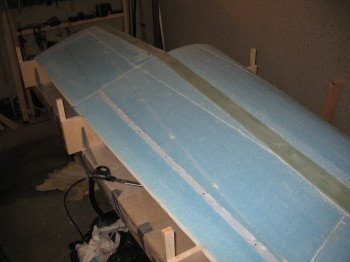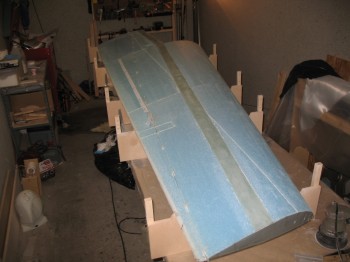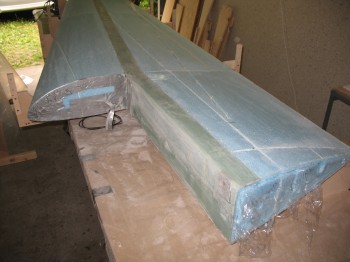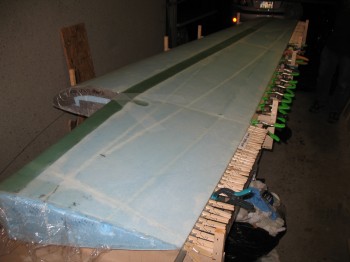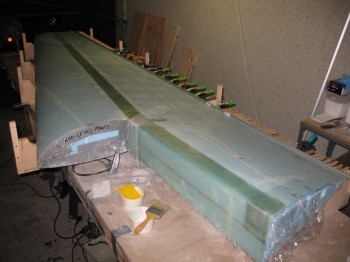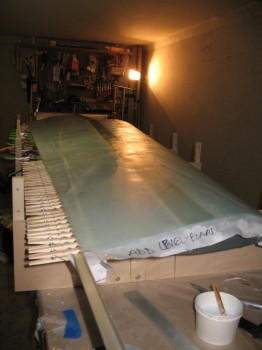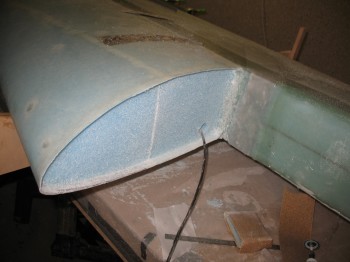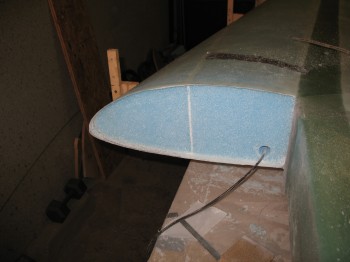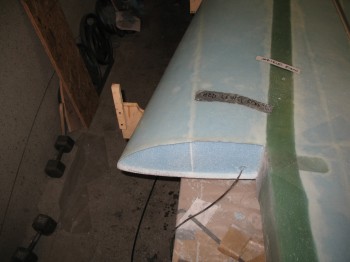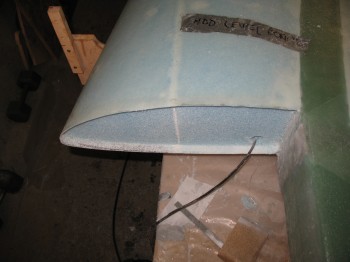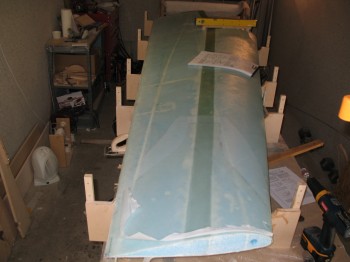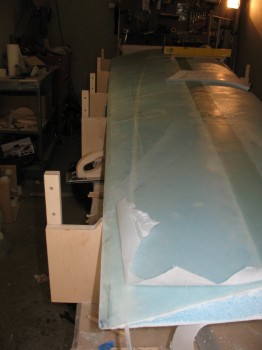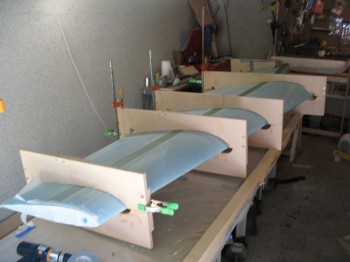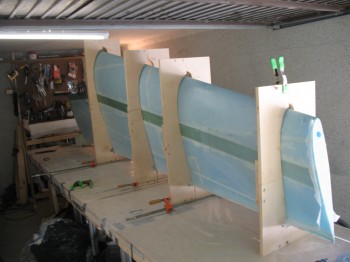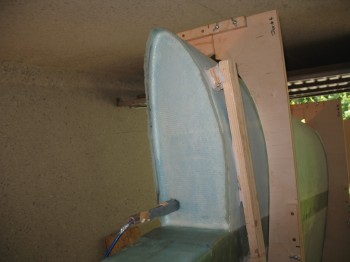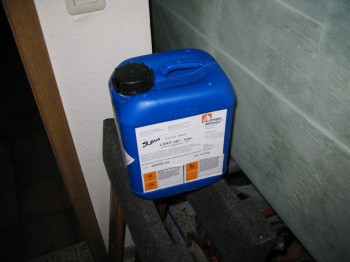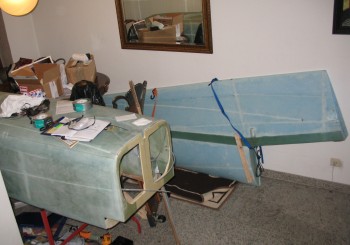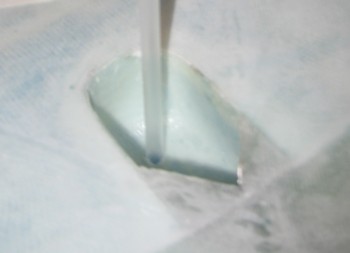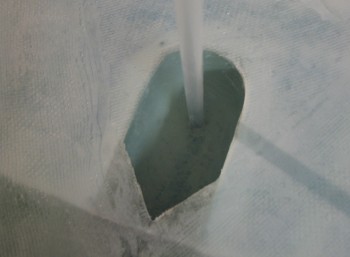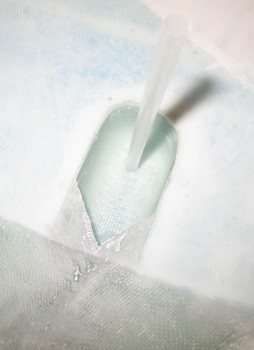Chapter 19 – Right Wing Build
27 July 2012 — After I put the fuselage away in its climate controlled storage facility (my dining room!), I did the final aligning, measuring & mounting of the wing jigs to the wing base… which was fairly time consuming to make sure the jigs were perfectly aligned, square, parallel, perpendicular . . . etc.
With the help of Gina & Kevin, I pulled out the Right wing cores, spread them on the portable workbench outside, and aligned them all together.
After duct-taping the foam edges to protect the foam as much as possible from stray wayward micro, we micro’d the core pieces together (FC1, FC2, FC3, FC5) and set them in the garage to fully cure. I should point out that there are 5 major sections of wing cores that make up the wing. Starting at the rear of the wing, on the inboard side (nearest the fuselage) is where the counting starts. The back half of the wing has 3 major sections: FC1 (INBD), FC2 (Middle), and FC3 (OUTBD). The front half of the wing only has two major sections, and it actually starts in the middle of the wing (since the strake makes up what constitutes the “Inboard” wing) and moves outboard. The front major sections are FC4 (Middle) and FC5 (OUTBD). Hopefully this will help put things in context whilst discussing wing core sections.
After the micro started setting up, I very carefully slid the first core segment into the wood wing jigs. I set the front wing half core on top of the rear wing half as you can see in the pic above. [This was just for testing the fit & picture purposes. The front wing core was not micro’d to the rear wing core at this point]. Since the micro was drying, we removed all the tape before it became a permanent part of the wing makeup (micro is some tough stuff… especially with tape!).
•••
28 July 2012 — Today I got to do something on the build I haven’t done in a while, as you may have noticed . . . I only worked on one thing out of one chapter! No multitasking!!
So being military I like to name the major parts of the build and often make references in my notes by those names. Thus, I have a codename, if you will, for the building of the wings:
OPERATION GOLIATH
Ha!
Ok, so let’s get to it… today I bonded FC2 & FC3 together in the jig.
Now the next step is something that is a pretty cool process, as Burt has many in his designs. When the wings are finished, the inboard area on the back half of the wing (FC1) is recessed so that the aileron control components have somewhere to live. This recessed area will be glassed on the top and bottom exterior (the wing upper and lower surfaces) and top, bottom and front (it’s a 3-sided piece-of-pie shape) on the interior. This is done by chopping off the inboard side of the wing with a wood saw (no kidding!), cutting away a big middle wedge so that only a 0.6″ of the top, bottom, front wedged-shaped “ring” is left (what will be the surfaces for glassing) . . . observe:
You’ll notice, in true Wade fashion, that there’s a couple of extra “seams” when I micro’d it back together. At some point in cutting off the outer 0.6″ edge it all came apart on me and ended up in two separate pieces. No worries, foam is easy to get back together with that wonderful stuff we call micro! The inside bottom of this pie-wedged shaped trough (as it sits in the pic below) will make up the inboard rib of the wing. The hole in the pic will eventually house the aileron control tube.
You can see in the background of the pic above (right) that the top piece that makes up the corner of FC4 is micro’d to the main part of FC4. At this point FC4 & FC5 are resting on FC2 & FC3, but they haven’t been attached to any other sections.
As you know, from time to time here in Germany some very friendly visitors stop in to check out what’s going on… here’s another one!
After I put FC1 back together and got ‘er micro’d all up, I took some time to scrub down all the primered aluminum wing extrusions with Simple Green & 3M Scotch Brite pads.
I then came back to FC1 after the micro had cured, placed the big hunk of foam back into the middle of the end rib area to strengthen and protect the currently fragile foam and proceeded to bond FC1 to the FC2/3 unit.
This is probably not a surprise to anyone, but the wing cores were not cut to perfection and some monkeying around comes into play when getting not-perfect wing core pieces to go together in non-perfect wing jigs! So, I had to play around a bit with the jig and FC1 to get it to line up on the end of FC2 just right. That entailed propping up the trailing edge of FC1 a little bit to make sure it all stayed aligned.
After getting the back half of the wing all put together, with FC1 attached nicely to the FC2/3 sections, I bonded the front parts of the wing, FC4 & FC5, together with micro.
I also took some shots going up & down the leading edge.
•••
29 July 2012 — Today I’ll be adding some 2024T3 aluminum extrusions to the wing build today. 2024 aluminum has an amazing strength-to-weight ratio and is some very tough stuff.
So far so good… everything looked straight and the micro seams were looking good.
I did have one minor issue, and again I think it comes back to how the wing cores are hot-wired (notice how I can use this as a root cause to the problem since I didn’t hot-wire the cores!). When FC4 & FC5 were sitting so they were butted end-to-end, there was a small gap between these two foam sections, but only on one side of the seam. I looked to sand the seam straight, but it would have caused either the inboard or outboard section to be short, and thus the front half of the wing short by just a tad. After playing around with it a little bit, it didn’t really seem like that significant of an issue… at least nothing more than a little extra micro wouldn’t take care of. In the end, after the 2 cores were micro’d together, there was about a 0.1″ gap in areas between the seam of the foam cores. Nothing horrific, but enough to warrant injecting some more micro in the seam between the FC4 & FC5 foam sections. Kind of like Botox, after a few injections it all looked pretty good!
On FC1 there will be 3 hard points for attaching the wing to the CenterSection Spar. Two of these hard points are Outboard (still on FC1 though) & one is very close to the Inboard edge of the wing. With the previous cutout at the end of the wing (end rib), obviously there is easy access to the single hard point at the very Inboard edge. But the 2 Outboard wing attach bolt hard points need an access point to put a wrench into the wing, at an angle nearly parallel to the surface of the wing . . . this needs to happen both on the top & bottom of the wing. So troughs are dug into the foam and glassed, but then all but an access hole is left when thick aluminum plates are added where the bolt will go through, and a thin “L”- shaped piece of aluminum covers up the majority of the trough and will subsequently get covered with a lot of 3″ UNI tape that makes up a very thick (comparatively, we’re talking 1/2″ . . . of pure fiberglass!) wing spar cap that runs from the inside edge all the way to the outboard end of the wing, both on the top and bottom of the wing.
I prepped the foam for the wing access bolt hard points in all 3 locations on FC1. I cut out the foam and shaped the channels for the access bolts on both the top and bottom of the wing on the Outboard side of FC1 (both the front & back side when it’s sticking straight up in the air).
After prepping the foam with a coat of thicker micro, I glassed in a 2-ply BID layup into each channel. I then micro’d in the two 2024 aluminum extrusions (LWA4) so they sat level with the top (front) of the wing assembly as it was then situated. I also micro’d in the lone aluminum extrusion (LWA6) on the Inboard edge so it too was flush with the top of the wing assembly.
After the BID layups had cured somewhat, I knife cut them so they were even with the foam surfaces on each side of the wing. I then floxed in the thin “L”-shaped pieces to what will be the top and bottom surface of the Shear Web & Spar Caps, and held them in place with finish nails while the flox cured.
Meanwhile . . . while I was messing about with the wing bolt hard points, Gina was busy helping to fix a boo-boo that was right on the face of what will be the shear web. She fashioned a foam plug to match the rather large chip that came off one the junctions of the major foam core sections at a top point where the foam was tapering very thin. She taped off the area and when I had some micro whipped up for the bolt access channels, we micro’d the fix plug in place.
After that was all taken care of, I focused on digging out the dead micro in the seams where the Shear Web will get glassed, while Gina taped plastic around all the wing areas OTHER than–and at edge of–the Shear Web to protect those areas from errant nasties while laying up the Shear Web.
•••
30 July 2012 — Shear Web Construction . . . a couple of points of note.
First, I don’t think I’ve really covered what a shear web is exactly. Partly, because I don’t know exactly. Why? Because I’m not a friggin’ engineer! A shear web is glassed using UNI in a hatch pattern that crosses the front of the current “top” of the wing (not the front portion that is rounded, but about halfway back and running down the entire middle of the wing).
The shear web starts on the top, travels forward 3″, then turns down the face of the shear web cap (again, this is in the middle of the wing) and then moves rearward 3″. In essence, it creates a Π shape cap when the wing is positioned pointed upwards, as it is in the jig. In this position, after the shear web is glassed, the front portion of the wing will get micro’d to the shear web and sit on the top of Π. Once it all cures, and the wing is an entire unit, the left & right sides of Π will be recessed, deeper at the middle and shallower at the wing tip. Then 3″ UNI tape will be laid in long strands onto the sides of Π in these recessed channels. (3″ UNI is not the same as UNI cloth, but very long thick strands of fiberglass traveling in one direction that essential cures into what can be described as a solid glass bar).
When the 3″ UNI tape is laid on the left & right side of Π which is actually the top of bottom of the wing, these create spar caps on the top and bottom of the wing. These spar caps are connected to each other via the shear web, so that all the torsional forces that act on the wing in flight (bending, flexing, twisting) are transmitted from the top spar cap to the bottom, and vice versa through the shear web. If the shear web was not present and it was only the spar caps, the wing foam alone could not handle the flight loads… and bad things would happen. Thus sayeth Burt . . . (well, kinda, with a little paraphrasing!)
Next, after a multi-hour long discussion with Randi (of the infamous Cozy Girrrls) a few weeks ago, I had acquired “the plan” on how to more easily lay up the shear web–again, using poor man’s pre-preg with a twist: aluminum foil– and the secrets for laying up the 3″ UNI tape spar caps.
Thus, without any further loquaciousness, I will get on with the build log . . .
I arranged some saw horses and prepped a long table for the shear web pre-preg. I then measured, drew & marked up the plastic sheeting. I prepped the wing foam at the shear web site & then pre-deployed epoxy & other glassing materials to the shop. I laid out all the UNI glass (that was cut last night) & double checked everything one last time.
With Gina manning the epoxy production station (again, so NICE to have help!) I wetted out the UNI shear web pre-preg.
Once the pre-preg was good & wetted out, I micro’d the shear web foam. I then replaced one of the plastic pre-preg sides with aluminum foil and translated the markings to the aluminum foil (these markings showed the center of the layup, both wing ends, and the 2 important “butt lines” [distance from aircraft centerline] that denoted the differences in UNI ply count). I then flipped the entire pre-preg set-up & pulled off the remaining layer of plastic so that only the UNI plies were left attached to the aluminum foil.
We then transferred the entire UNI pre-preg layup to the wing assembly and flipped it like a flapjack onto the micro’d shear web foam. After getting all the markings aligned, we started vigorously squeegeeing the aluminum foil from the centerline of the layup out to remove any air & to set the glass onto the micro’d foam. The aluminum foil was much stronger then I imagined it would be and really allowed for some hearty squeegeeing action.
[Critical Note: After using the pre-preg method for laying up his shear web, Marco found a number of air bubbles in his cured shear web. In the ensuing discussions he had with various members of the old guard builders, he found that using pre-preg for the shear web may cause the interior layer of UNI to be misaligned. His issue was compounded by his use of EZ-Poxy which has a much higher viscosity than MGS, and you can’t see through the glass layers to assess the plies underneath the top plies. After a long discussion, and my memory (a rare thing for many parts of this build) of the shear web layup, I’m confident my bottom/interior glass plies are good. Still, I would highly recommend to any builders reading this that you strictly follow the plans in laying up your shear web!]
After getting the glass squeegeed out & set, I began to pull sections of the aluminum foil off the layup and cut the edge of the glass with another Cozy Girrrl indorsed tool: “Dritz” electronic scissors. I cannot even begin to tell any composites builder how amazing these scissors are & what a huge time-saver they turned out to be! 5-stars across the board on the Dritz scissors. If you are a canard builder, get these scissors if you don’t have them. Ok, I digress.
After the UNI shear web was laid up, but with the epoxy still wet, it was time to attach the front portion of the wing (on top in this position). We applied micro to the bottom of the FC4/5 assembly and then positioned it onto the shear-webbed aft wing assembly, and then peel plied the “sides” of the shear web (at this point technically the “sides” of the shear web are really “spar caps”). Also, to ensure that the front portion of the wing was properly aligned with the rear part, all the jigs were re-bolted back together, encasing the new wing structure.
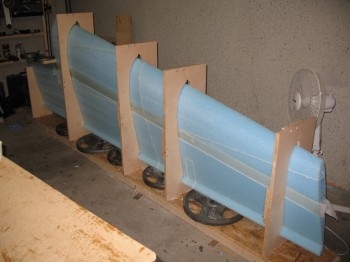 I laid up 2 sets of 3-ply BID pads directly over the previously embedded aluminum extrusions & newly glassed UNI shear web as a base for 2 more 2024 Aluminum extrusions. These 2 added extrusions were then attached & epoxied in place over the newly glassed shear web & 3-ply BID pads. The new Inboard extrusion (LWA2) was approximately the same size, while the Outboard extrusion (LWA3) was a single longer extrusion that spanned the width of the wing/shear web and covered the 2 individual/previously embedded extrusions. To ensure the extrusions & glass coverings were securely in place, weights were added to compress the layups & squeeze out any air and/or excess epoxy.
I laid up 2 sets of 3-ply BID pads directly over the previously embedded aluminum extrusions & newly glassed UNI shear web as a base for 2 more 2024 Aluminum extrusions. These 2 added extrusions were then attached & epoxied in place over the newly glassed shear web & 3-ply BID pads. The new Inboard extrusion (LWA2) was approximately the same size, while the Outboard extrusion (LWA3) was a single longer extrusion that spanned the width of the wing/shear web and covered the 2 individual/previously embedded extrusions. To ensure the extrusions & glass coverings were securely in place, weights were added to compress the layups & squeeze out any air and/or excess epoxy.
I went through and double-checked the shear web/spar cap layup, especially the edges. I ensured the peel ply was applied correctly, the weights & extrusions looked right, and the front/back (top/bottom actually) spacing between the front & rear sections of the wing were correct. Also, the spacing on the jigs looked good & the alignment was correctly maintained.
•••
31 July 2012 — I started out today by removing the protective duct tape & nails used in bonding the pieces together for the LEFT wing’s FC2 section. I also cut the 6″ wedge off the Left wing’s FC1 section for the hollow/inset Inboard end rib.
Back on the Right wing, I drew a line & cut off a wedge at the most Inboard part on the front portion of the wing. This will allow the front of the wing to align correctly with the fuselage-side strake later on after the strakes are built.
I then whipped up some flox and floxed the jigs to the top wing surface by applying a small dab of flox every 6-12″ along the corner intersections of wing foam to wood jig (seen in the picture above).
I spent a couple of hours constructing a long work table for the wing builds and getting it as straight & level as possible. Due to the size of the wings this new & improved work bench is much longer then the previous one.
I then unscrewed the wing jig base from its wood pedestal and placed the wing–in the jigs–bottom side up on the work table. I leveled all the wing jigs to ensure they all matched & thus the wing washout (the shape of the wing as in how it twists, or “flows”) was as close to the intended design as possible. Once all the jigs, and thus the wing, was as level as I could get it (there were some slight anomalous variances I mitigated as best possible, but that I could simply not eliminate) I hard mounted the jigs to the table using L-brackets & screws.
I prepped a 1×2 strip of wood which will be used as a dam while laying up the 3″ UNI tape spar caps. I covered the parts of the wood dam strip that will contact the layup with duct tape. I then bondo’d & clamped the dam strip to the shear web at the inboard part of the wing where the aft wing section extends farther Inboard than the front part of the wing.
With the bondo on the dam cured & good to go, I taped off the edge of the spar cap (shear web glass) with plastic to protect the wing foam surfaces. I also set up the 3″ UNI tape on its dispenser stand.
•••
1 August 2012 — I sanded down a bunch of the Spar Cap (aka “Shear Web”), with a fair amount being in the middle wing area specifically. It appears that during the shear web layup that some of the redundant plies at the outer Butt Line marker–where the number of UNI plies went from 4 down to 2–were a little bit more redundant than they should have been. I’m not sure why I wasn’t able to catch these 3 errant bumps when I was peel plying the shear web, but they were certainly apparent the next day. I sanded them down with my sanding board, and got the Spar Cap base back to a fairly level surface. While I was in prep mode, I also found 3 small areas with air pockets… so I drilled holes & injected them with epoxy.
As per, “the plan” that I developed when I talked to Randi from the Cozy Girrrls, I made some epoxy runoff downspouts and tacked them into position at each end of where the spar cap’s 3″ UNI tape would be laid up into the wing.
I then micro’d the channels & the foam running down each side of the spar cap, the entire length of the wing. I laid up the spar cap with 3″ UNI tape as per plans, with the extra plies required as per CP 25 since my 3″ UNI was a bit on the thin side. Again, thank God Gina was there manning the epoxy station… because this layup took quite a bit.
After all the 3″ UNI tape plies were laid up (after about 5 hours worth of glassing!), I peel plied the spar cap using 3″ peel ply off a roll.
I then cut each end of the spar cap & removed the runoff spouts. I cleaned up the exposed Inboard shear web while Gina carefully removed the plastic.
Later that evening I sanded down the top of the spar cap & also leveled it out at the foam junction. Now, the 3″ UNI tape used in the spar cap is made from S-glass, the same glass used in the landing gear bow. For all practical purposes, the next thing up the evolutionary chain as far as fiberglass cloth goes, is from E-glass (UNI & BID) to S-glass (Landing gears & 3″ UNI tape spar caps) and then Carbon Fiber. But my point in bringing this up is that S-glass is a lot harder to sand, and infinitely itchier than E-glass. Yuck!
After the ‘bad’ sanding period was over with, I proceeded to clean up all the micro joints to remove ALL dead micro, and any micro that decide it was above all else (e.g. Wing surface!).
After a couple hours manning the Dremel, I removed the dam bondo’d to the Inboard side of the wing & sanded down the entire Inboard area.
I then turned my sights back onto the Left wing & cut the 6″ wedge from the Inboard side of FC1. Once I cut out the center wedge part, I micro’d the outer shell back to FC1 (Gina was mixing micro and helped a lot with this as well). I then micro’d the two FC2 parts together.
After finishing with the Left wing sections, I refilled the epoxy & hardener bottles, and checked the levels of all my consumables.
As I was checking the wing one last time for the evening, I went ahead and grabbed a sanding block and very carefully sanded & shaped the Leading Edge of the wing.
•••
I touched up & finalized sanding the leading edge (LE) of the Right wing in prep for glassing the bottom of the wing. I also finished cleaning up the micro joints & had to reflox the upper wing surface to Jig #4.
I vacuumed the entire wing surface in prep for glassing. I then floxed in a baggage pod threaded insert for a tie-down hard point.
I cut RG-58 coax & 3/8″ copper foil strips to length for an FM radio antenna (26.2″ each leg). I prepped & soldered the coax cable to the copper strips using Rosin core solder. I chose to do the FM antenna first, that way if I jacked it up while glassing, I could use it as a learning experience.
I installed the antenna onto the wing, and then I tacked on 1″ peel ply strips to the wing trailing edge (TE) and at the front edge of what will become the ailerons.
I taped up both ends of the wing to protect the foam from epoxy, gunk, etc. and also along the front leading edge, so that the wing top LE (down in these pics) would be protected & fresh when it comes time to layup the wing top surface. I then wet-micro’d the surface & dry-micro’d the grooves, indents, bumps, valleys, etc.
I glassed the UNI skin layups onto the surface of the lower Right wing. After the main UNI skin was laid up, I added the triangular BID reinforcement at the Outboard area & peel plied.
I peel plied a 2″ strip along the LE & 3″ peel ply strips at the wing bolt access hole.
Talking to a couple of seasoned builders, they said I should try throwing on some thick micro–using the West system–after the skin layup was tacky. This would kill two birds with one stone in theory since I would have my finishing micro in place and not have to sand to finish later on. I tried it on two wide swaths, and wasn’t overly impressed with the outcome. I was too tired & too committed after it was on, but learned that I would rather go the hard route of sanding, filling and finishing later on than take this shortcut.
After the wing cured a bit, I knife trimmed the LE & removed the duct tape along the LE.
•••
3 August 2012 — I micro’d the Left wing’s FC5 section.
Sanded some channels into the micro I applied for some test finishing so I could get a couple of the jig halves remounted, and then test fitted the jig mounting to the bottom of the wing.
I then knife trimmed both the Outboard & Inboard wing edges, the front of wing jut-out (B.L. 55.5) and the trailing edge (TE). I also applied dry micro down the TE channel.
After I attached all the jig tops (top in picture, technical “bottom” of wing), I grabbed my favorite can of German bondo and bondo’d the jigs to the bottom surface of the wing.
Once the bondo had cured, I unscrewed the jig mounts & flipped the wing over. Of course I had to snap a few pics on its way over.
I spent a fair amount of time leveling & aligning the jigs/wing. Once level, I then mounted the bottom jigs to the workbench using the same L-brackets that I had on the other side.
After removing the top of the jigs, I pulled the spar cap peel ply off (applied when I glassed the shear web & attached the front part of the wing).
I also removed the “fish tail” on the TE & started removing some of the peel ply that I had tacked in before glassing the bottom of the wing.
After spending an inordinate amount of time removing the peel ply from the trailing edge (I think splitting atoms with a dull ax would be easier… and less time consuming!), I focused on cleaning up the spar cap channel by using the Dremel tool to remove dead micro & wayward glass fibers from the edges of the channel.
For the Left wing, I micro’d the pieces of FC4 together.
•••
4 August 2012 — I built the dam for top side wing spar cap channel & bondo’d it into place. (The weights in the pics below were left over from being used during the leveling & alignment of the wing while attaching the jigs to the work bench surface)
I used the Dremel to clean up the sides of the spar cap channel some more. Once I finished getting spar cap channels prepped for glass, I vacuumed the wings & spar cap channel. I then taped up the edge of the spar cap and laid plastic down across the foam wing pieces on both sides of the spar cap to protect it from epoxy.
Gina built a new set of epoxy runoffs/downspouts for me. I then prepped for the ensuing multi-hour marathon spar cap layup. I prepositioned the 3″ UNI tape roll on its dispenser stand assembly at the end of the table.
I then pre-cut a good majority of the long 3″ UNI tape that will run full length down spar cap trough, and then get successively shorter with each new piece… generally around 3″-6″ shorter on each end as it pyramids up to the final piece which is only 20″ long on the top of the wing & 17.5″ long on the bottom of the wing. With the added layers per CP 25, there are 7 layers of 3″ UNI tape on the bottom wing spar cap, with the top getting 10 layers.
I then laid up the spar cap & peel plied it (sorry, no pics just yet . . . ). As I kept on laying in the 3″ UNI tape, Gina was working the epoxy station (Did I mention how nice it was to have help?!)
•••
5 August 2012 — Today I removed the peel ply and surrounding tape from the spar cap. Since I had finished so late last night, I crashed without thinking about the ramifications of letting the epoxy fully cure (Read: mistake) with the protective tape & plastic still attached. I guess that’s why God invented Dremel tools huh?! To remove strips of duct tape that remain ensconced along the edges of the spar cap.
I removed the FC1 dam that was bondo’d on, and proceeded to chisel off large chunks of bondo, wood & epoxy. After I got most of the big pieces off, I sanded down & even Dremelled a little bit of the crud left behind from the dam in the entire area where the dam had once been.
I went ahead and floxed in the threaded hardpoints for the baggage pods. Obviously, I didn’t flox in the 4 hardpoints on the bottom of the wing & will wait until I actually install the baggage pods for those. I’ll do the 2 on the top of the wing since they are much more visible, and I’d like the holes to be as clean as possible. For the measurements, I came back 1.75″ from the LE & set them 4″ apart.
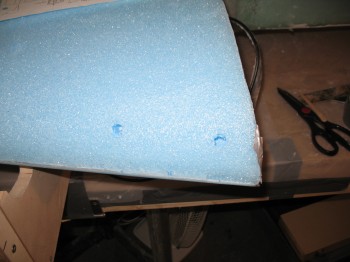
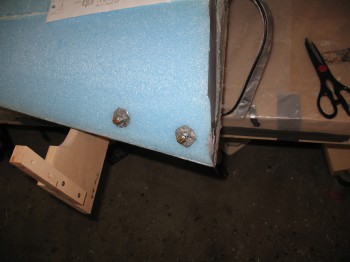
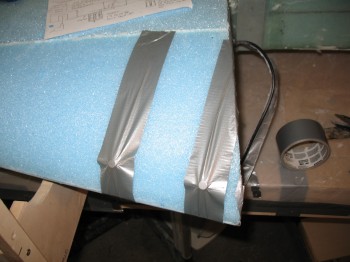 After I got the threaded hardpoints for the baggage pods floxed in, I cut the ends of the spar cap flush with each end of the wing.
After I got the threaded hardpoints for the baggage pods floxed in, I cut the ends of the spar cap flush with each end of the wing.
I then grabbed my trusty Dremel & went to work on the sides of the spar caps once again to rid the wing of dead micro & epoxy.
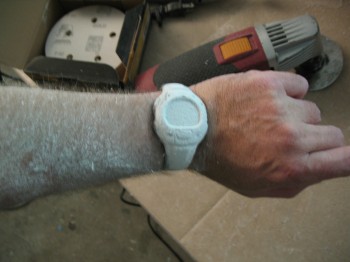 I used the orbital sander to clean up the top of the spar cap. Now, unlike the pic above, where I was using the Dremel Tool on micro, when I sanded the spar caps I wore long sleeves and was all buttoned up (S-glass itches!!).
I used the orbital sander to clean up the top of the spar cap. Now, unlike the pic above, where I was using the Dremel Tool on micro, when I sanded the spar caps I wore long sleeves and was all buttoned up (S-glass itches!!).
I removed some more, but not all, of the TE peel ply strip.
I then–again, in fine Wade fashion–as I was trying to remove the block of foam from the Inboard wing end…. well, let’s just say it came out, but it wasn’t about to come out alone! Not without an actual piece of the wing! Ugh!
So . . . I’ll micro the piece back in tomorrow before I glass the upper wing.
I then used the Dremel to router the channel for the rudder cable Nylaflo. I followed the measurements as laid out in the plans, but got just a hair too close to the hollow aileron cavity on the Outboard upper corner and left a decent size channel for a few inches. So I spent a little bit of time cleaning that up & prepping the repair. I’ll actually micro in a foam repair piece tomorrow as well.
•••
6 August 2012 — Today I removed the bolts/taped washers from the baggage pod threaded inserts & Dremelled the edges flush with the wing foam surface.
I then removed the remaining peel ply strip from the TE & it wasn’t that bad (I’m lying! Removing TE peel ply sucks!)
I micro’d in the Nylaflow rudder cable conduit & kept it in place with toothpicks about every 10-12″, after micro’ing in my ~5/16″ x 4″ repair piece into place as a channel “false floor” for the Nyloflow as it traverses the front aileron cavity. I’ll cutout any excess foam once I cut out the aileron and start working in the aileron channel.
I also tacked on a 65″ x 1″ strip of peel ply at the aileron’s top “leading edge,” on the wing side (essentially above the aileron to wing junction, only on the wing side).
I then vacuumed the entire wing & finalized all the preps for glassing the top.
I reinserted the big block of foam back into the Inboard wing root end (BL 23). Before I reinserted it, I wrapped it in saran wrap so the repair micro wouldn’t fasten the removable foam to the wing, and thus make it NON-removable (aka bad!). I reinserted the broken piece, but will wait until I actually start glassing the wing to micro it in.
I checked the micro holding the Nylaflow rudder cable conduit in place, and it had not yet started to get tacky, so I took a break while the micro cured a little bit more. I didn’t want to layup the top glass just to have conduit trying to escape its micro bonds and thus deform the wing surface layup.
In the meantime, I went downstairs and micro’d the Right upper winglet pieces together (there were no more Left wing sections to micro since they were all bonded together–in their respective sections FC1 thru FC5–and ready to be assembled).
When I returned to the shop, I took a good look at the wing & used my flat sanding board to clean up the wing surface, especially at the joints. I wanted to ensure a smooth flow over the wings, which honestly is much more important on the wing upper surface than it is the bottom. Of course, having re-sanded the wing, I had to vacuum the entire upper wing surface again.
I micro’d the foam joints & the spar cap edges (no micro goes on the spar caps, just wet epoxy!) with dry micro. On the large areas of plain foam (what I call, “the field”) I used wet microslurry.
In laying up the UNI on the wings I used up all the slow hardener I had prepped in my 2 squeeze bottles. The transitions looked good, and at only ~70°F the epoxy seemed to be curing fairly fast. I added the triangular BID reinforcement at the Outboard end of the wing & covered it with peel ply. I then glassed a staggered 3-ply UNI layup over the Inboard wing bolt extrusion, that covers the extrusion and then folds over the edge of the wing and is laid up on the top front corner of the wing surface as well. Also, I clamped the TE with a long piece of L-shaped aluminum to ensure the TE was as straight as possible.
I peel plied the “V” that straddles the upper wing bolt access hole, and as you can see, wrote out a couple notes admonishing myself not to forget the wing level board that must be bondo’d to the top at 0° incidence, so that the wings can mounted at the correct incidence angle.
•••
7 August 2012 — I started out today by checking the top of right wing layup… looked good! I did a rough knife cut on both the front & aft Inboard rib areas. I then used a saw to refine my cuts & trim the glass at each end of the wing.
I then removed the clamps & angled aluminum from the TE… which also looked good.
I used the router to cut & shape the 0.7″ inset into the BL 55.5 wing rib (front jut out). After the foam was shaped & the glass was prepped (via Dremel Tool), I cut & glassed 3″ UNI strips that make up the “V” and border each side of the bolt access channel holes.
I then set & bondo’d the incident board onto the top wing surface (no pic yet).
•••
8 August 2012 — I started off today by knife cutting & finished glassing around the wing bolt access channel holes.
I cut the Trailing Edge (TE) on the Right wing, then sanded it & cleaned it up a bit.
I stood the jigged wing up on end to glass the BL 55.5 rib.
I pre-pregged 3 large pieces of BID, micro’d the foam and filleted the inset corner between the glass & foam with dry micro. I then laid up the BID plies into the BL 55.5 rib inset.
I ran some errands while the BL 55.5 rib layup cured. A few hours later, after the epoxy had set some, I knife cut the edges. The BL 55.5 inset rib was fairly cured after some preparations & staging of materials for the upcoming Left wing build, including refilling all the epoxy & hardener bottles. As you can see below, since I’ve been in Germany I’ve used almost 1.3 gallons of MGS slow hardener:
I moved the Right wing into the climate controlled storage facility with the fuselage (again, my dining room!).
•••
21 June 2013 — Today I took a bit of time to drill a hole from the top side of the Right wing’s attachment bolt channel to the bottom bolt access channel, as spelled out in Canard Pusher Newsletter #38 page 5. This allows pooling condensation in the upper side bolt access channel to drain down to the lower bolt access panel, and then out a small hole that is drilled in the bolt access channel cover plate. Unfortunately, since I got busy with my move stuff, I was only able to get the hole drilled and the drinking straw micro’d in on the Right wing, so I’ll have to get to the Left wing’s drain next year.
•••
